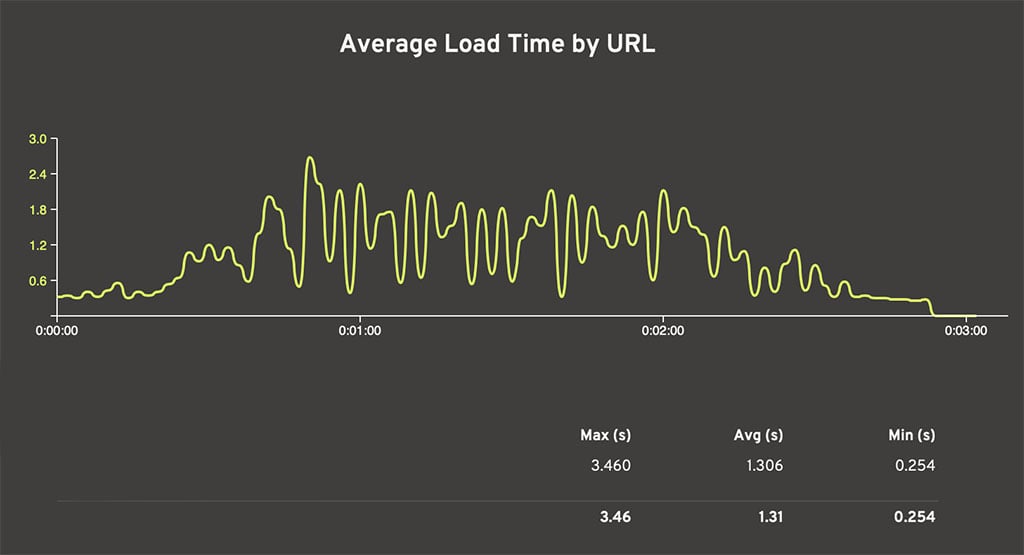100x performance; it’s a big and bold claim! If you’ve spent time researching web hosting options, you’ve no doubt come across plenty of impressive figures and striking data as to why you should choose service X over Y.
You’ve more than likely pondered what they all mean, too. With this post I wanted to dive into the detail behind our own claims; why you can expect more than 100 times the performance from an optimised WordPress Hosting plan.
Our testing methodology
To gauge the potential performance gains from employing an optimised WordPress hosting setup we took our own entry level WordPress Hosting plan and a bare-bones VPS server, created with a simple LEMP stack, on identical hardware, and with identical basic specifications. Each test account was setup with a vanilla installation of WordPress. The test looks at how each performs ‘out of the box’ with the very simplest of sites, uncluttered by themes and plugins.
We used the Loadster testing tool to deliver an ever increasing number of simulated users to each of the two test servers. The tests began with relatively low user loads, culminating with thousands trying to access the server. The tests compare how the two setups perform under stress, with a growing number of concurrent users trying to access the hosted WordPress websites.
The results
As part of this test, we’re primarily studying the “Average Load Time by URL”. This is a measure (in seconds) of how long it takes a simulated website user to receive the web page in their browser. Naturally, quicker is better. Slower load times mean users impatiently waiting for the page to load. The longer the user waits, the more likely they’ll simply quit and move onto the next website. Moreover, quality metric tools like Google’s Page Speed Experience monitor this behaviour, with poorly performing sites at risk of losing prominence in search results.
So let’s get started. Here’s the first test: a relatively trivial twenty five users at once accessing each server. In the graphs below, the X axis shows the duration of the test in minutes. Along the Y axis is the time in seconds for the server to successfully return a webpage to a site visitor.
25 concurrent users
Barebones VPS

The basic server copes competently with this modest level of demand. The response times aren’t blazingly fast, but they’re stable. Over the testing period we can see peak load is experienced around the one minute mark and stabilises quickly. Pages are served consistently with about a 1-2 second wait time. It’s not perfect, but it’s arguably an acceptable experience for some website owners.
WordPress Hosting

The optimised WordPress hosting is noticeably different in testing even at this low threshold. After some initial caching of pages, response times are consistently in the 0.009 second range. They remain there for the duration of the test.
50 concurrent users
Barebones VPS

As the number of concurrent users increases, the basic VPS server starts to struggle. Here we can see the response times more than tripling; at some points even slowing to more than 8 seconds per user.
WordPress Hosting

No such problems exist with the optimised platform. The results mirror the previous test identically. A consistent, ultra quick response time.
100 concurrent users
Barebones VPS

As we continue to increase the number of users, the basic VPS server starts to crumble under the weight of demand. The graph above demonstrates a consistent slow down in page load time. The peak slowdown sees users receiving a webpage with a delay of nineteen seconds. Surely a long enough delay for the user to abandon the website entirely. Moreover, if the test duration was extended, the peak load time would increase further. The graph simply tails off as the three minute testing time ramps down.
WordPress Hosting

This graph should look familiar by now. The optimised platform doesn’t even blink with the doubling of demand to 100 users at once.
500 – 2000 concurrent users
It makes sense to stop testing the bare-bones server at this stage. As we saw in the previous test, even 100 concurrent users is enough to create a spiralling slowdown as the server struggles to keep pace with user demand. At higher ranges like 500 – 2000 concurrent users, the problem would become compounded. The server would follow a linear path of slowdown, ultimately experiencing hard errors and more than likely complete failure.
But what about the optimised WordPress Hosting at such levels?


As you can see from the graphs above, the server continues to shine, even at mammoth levels such as 2000 users at once. Much of what you see in these graphs are the core differences between basic hosting and optimised WordPress Hosting. For example, our own WordPress Hosting is built from the ground up using multi-layered caching technology, all tweaked from years of daily WordPress experience. This is also just one facet to consider, I’ll leave the huge contrasts in security and reliability tweaks to another story.
What does this all mean?
The universal appeal of WordPress is understandable. Even a basic, non-optimised platform can deliver a reasonably acceptable level of performance; at least when the website is experiencing low usage. Under ideal scenarios, this would be perfectly acceptable for many users. Ideal scenarios are just that however, and any smart business owner hopes for the best, but plans for the worst.
Sporadic surging traffic isn’t as uncommon as you might imagine. Every week we assist our clients encountering unexpected website traffic. Perhaps a mention in the local news, larger national TV or radio, a viral social media spike, or simple businesses seasonality.
It goes without saying the above data comes with sensible caveats. Again, the servers used for testing had nothing but basic default themes installed. The use of themes, page builders, and plugins can all alter the performance of a website. That said, building your site on the fastest possible foundation seems like a smart move to me.
Bonus note: those keen eyed maths types might have spotted one error in all of my data. While I claim 100x performance, the reality is some 130x. Come and try it out for yourself today.



